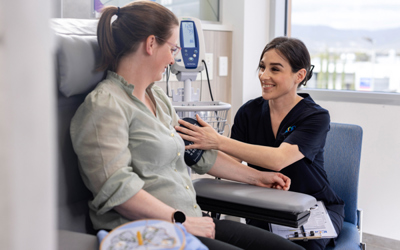What is haemochromatosis?
Hereditary haemochromatosis (also known as familial haemochromatosis or inherited iron overload disorder) occurs when the body absorbs and improperly stores too much iron from the diet.
People with haemochromatosis absorb too much iron from their food. Over time this leads to iron overload. The extra iron is stored in the body in places where it can cause problems, for example the liver, heart, pancreas, pituitary gland and other organs.
Who is at risk of haemochromatosis?
Hereditary haemochromatosis is the most common genetic disorder in Australia.
Approximately 1 in 200 Australians with Northern European ancestry inherit the genes that cause haemochromatosis – meaning they may develop the clinical condition during their life. People of Celtic origin are at higher risk than people from Southern Europe.
Both men and women are at risk from haemochromatosis. However, women tend to develop the condition later in life because they lose blood from menstruation during child bearing years. However some women will develop symptoms at an early age.
Signs and symptoms of haemochromatosis
In the early stages of hereditary haemochromatosis, iron begins to build up in the body, but people may not show any symptoms. Then as time goes by, they may become unwell. However, people with hereditary haemochromatosis don’t always have the same symptoms. The condition can be difficult to detect and tends to be under-diagnosed, partly because its symptoms are similar to those caused by a range of other illnesses and are vary in their intensity.
Symptoms of hereditary haemochromatosis can include:

Tiredness

Weakness and generally feeling unwell

Sore joints (especially in the knuckles, knees and ankles)

Stomach pains

Unexplained weight loss

Irregular heartbeat

Sexual dysfunction
For people with hereditary haemochromatosis, the extra iron stored in the organs and joints builds up gradually over many years. Over time, the liver becomes damaged, leading to serious diseases such as cirrhosis and liver cancer. Other organs such as heart and pancreas can also be affected and ultimately damaged. Without treatment, haemochromatosis can cause permanent organ damage and even early death.
How is haemochromatosis diagnosed?
Blood tests are used to detect iron overload and to diagnosis hereditary haemochromatosis. The blood tests you may have include transferrin saturation (TS), serum iron and serum ferritin.
Transferrin is a protein that carries iron in the blood. A transferrin saturation (TS) test shows how much iron the transferrin is carrying
A serum iron test measures how much iron is present in the blood
A serum ferritin test measures the amount of iron the body has stored.
If your blood tests show iron overload and/or you have a family history of haemochromatosis, then your doctor may request genetic testing (HFE studies) to confirm if you have hereditary haemochromatosis.
Your doctor may suggest other tests, such as a liver function test, to confirm the diagnosis and to look for other problems.
Treatment for haemochromatosis
There is no cure for haemochromatosis but regular blood removal (or venesection) is used to lower your blood levels to normal. The procedure for blood removal is similar to blood donation, where around 450-500mls of blood is removed until iron in the blood is reduced to normal. The amount of blood removed and how often it is removed depends on your age, overall health and how severe your iron overload condition is.
It may take a year or longer to reduce the iron in your body to normal levels. People with haemochromatosis should keep their iron levels monitored regularly by their doctor. If diagnosed early, the outlook for haemochromatosis is very good.




